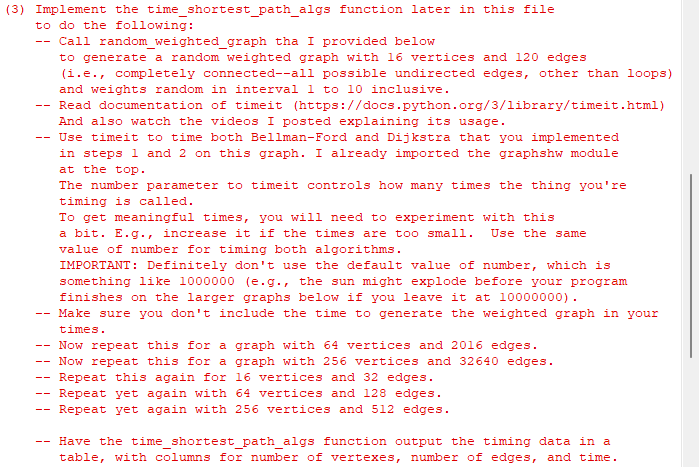Given below is the implementation of the bellman ford and dijkstras algorithm. Please complete the code for the time_shortest_path_algs() function according to the instructions in the 1st screenshot provided. Done in python 3.10 or later please def bellman_ford(self,s) : """Bellman Ford Algorithm for single source shortest path. Keyword Arguments: s - The source vertex. """
Given below is the implementation of the bellman ford and dijkstras
def bellman_ford(self,s) :
"""Bellman Ford Algorithm for single source shortest path.
Keyword Arguments:
s - The source vertex.
"""
distances = {v: float('inf') for v in self.adjacency_list}
distances[s] = 0
parents = {v: None for v in self.adjacency_list}
for _ in range(len(self.adjacency_list) - 1):
for from_vertex in self.adjacency_list:
for to_vertex in self.adjacency_list[from_vertex]:
if distances[from_vertex] + self.weights[(from_vertex, to_vertex)] < distances[to_vertex]:
distances[to_vertex] = distances[from_vertex] + self.weights[(from_vertex, to_vertex)]
parents[to_vertex] = from_vertex
for from_vertex in self.adjacency_list:
for to_vertex in self.adjacency_list[from_vertex]:
if distances[from_vertex] + self.weights[(from_vertex, to_vertex)] < distances[to_vertex]:
# Negative cycle found, return empty list
return []
# No negative cycles found, return list of 3-tuples
return [(v, distances[v], parents[v]) for v in distances]
def dijkstra(self,s) :
"""Dijkstra's Algorithm using a binary heap as the PQ.
Keyword Arguments:
s - The source vertex.
"""
distance = [math.inf for x in self._adj]
parent = [None for x in self._adj]
Q = PQ()
distance[s] = 0
Q.add(s, 0)
S = []
for u in range(len(self._adj)):
if u != s:
Q.add(u, math.inf)
while not Q.is_empty():
u = Q.extract_min()
S.append(u)
for v, w in self._adj[u].__iter__(True):
if (distance[u] + w) < distance[v]:
parent[v] = u
distance[v] = (distance[u] + w)
returnlist = []
for v in S:
returnlist.append((v, distance[v], parent[v]))
return returnlist
![def random_weighted_graph (v, e, min_w, max_w) :
"""Generates and returns a random weighted
graph with v vertices and e different edges.
Keyword arguments:
v number of vertices
e number of edges
if
min_w - minimum weight
max_w - maximum weight
edges = [ (random.randrange (0,1), i) for i in range (1, v) ]
# if desired number of edges greater than length of current edge list, then add more edges
if elen (edges) :
edgeSet = { x for x in edges }
not YetUsedEdges = [ (y,x) for x in range (1,v) for y in range (x) if (y,x) not in edgeSet]
random.shuffle (not YetUsedEdges)
count = e = len (edges)
count = min (count, len (not YetUsedEdges))
for i in range (count) :
#generate random edge weights
weights = [random.randint (min_w, max_w) for x in range (len (edges)) ]
edges.append (not YetUsedEdges.pop())
# construct a Digraph with the lists of edges and weights generated
G = WeightedGraph (v, edges, weights)
return G
def time_shortest_path_algs():
"""Generates a table of timing results comparing Dijkstra and Bellman-Ford."""
name
-
==
main":
#Here is where you write some code to test that your algorithms
#are correct.
#It is also where you will call your time_shortest_path_algs function.
#Don't forget to save output to a text file](/v2/_next/image?url=https%3A%2F%2Fcontent.bartleby.com%2Fqna-images%2Fquestion%2F0d59b49e-3987-421f-888e-fd2b8b6a0cc6%2F2f0c6e16-be81-4a00-a13d-da0b2f53a47c%2Fwez3vt_processed.png&w=3840&q=75)

Step by step
Solved in 3 steps with 1 images

How do I get the shell to then output these results?








